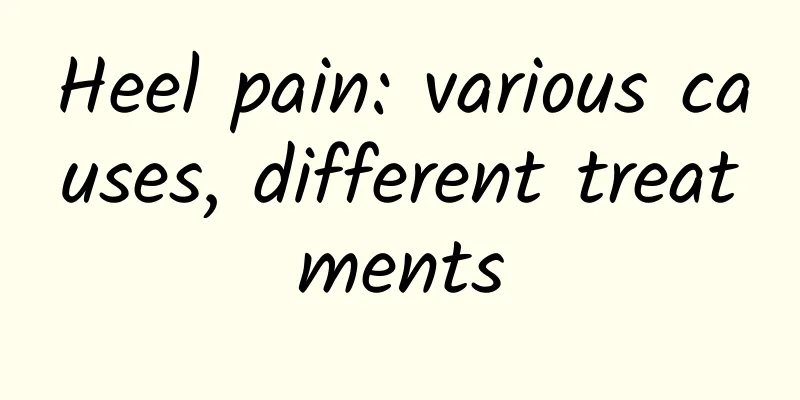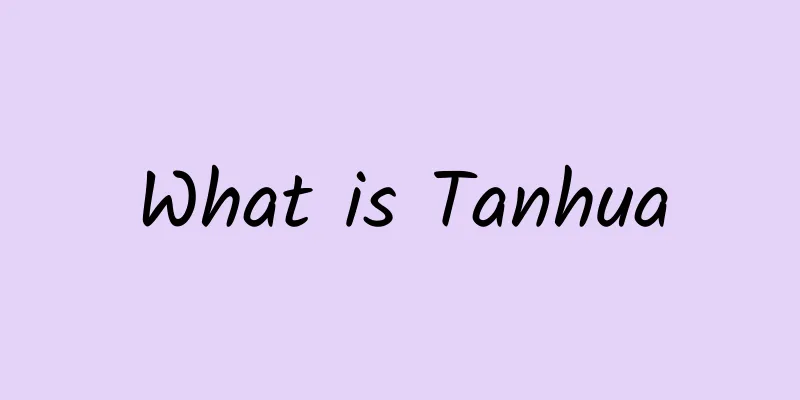Heel pain: various causes, different treatments

|
Author: Jie Baojuan, attending physician of the Southern District of Guang'anmen Hospital, China Academy of Chinese Medical Sciences Reviewer: Jiang Lei, deputy chief physician, Beijing Tiantan Hospital, Capital Medical University In daily life, it is normal to have foot pain if you walk too much, run too far, stand for too long or wear the wrong shoes. Generally, it can be relieved by changing the foot posture, resting, massaging, soaking feet, etc. However, if the heel pain and swelling persist for a long time and occur repeatedly, sometimes accompanied by a burning or tingling sensation, or even pain when resting, it may be caused by heel pain, which requires our special attention. Today, let's learn about heel pain, which is the heel pain we often hear. Figure 1 Copyright image, no permission to reprint 1. Do you understand radicular pain? Heel pain refers to pain in the heel when bearing weight caused by a series of diseases. It is not an independent disease, but a symptom caused by heel disease. It is pain caused by chronic strain of the calcaneus itself and the surrounding soft tissues. It is named after heel pain. Heel pain includes heel spurs, heel bursitis, heel fat pad inflammation, plantar fasciitis, etc. According to traditional Chinese medicine, the main causes of this disease are trauma, external pathogenic invasion, kidney deficiency, etc.; the basic pathogenesis is that the blood vessels are damaged, and the blockage of qi and blood leads to pain; kidney deficiency and lack of nourishment of bones lead to pain. The disease is located in the tendons and veins of the heel, and the nature of the disease is deficiency of the root and excess of the symptoms. Zhu Danxi also recorded it as "heel pain" in "Danxi Xinfa". 2. Who are the people who are prone to heel pain? The disease mostly occurs in people over 40 years old, and 25% of the patients are over 50 years old. However, with the popularity of high heels and the increase in running enthusiasts, the age of patients is tending to be younger. The risk factors that easily induce this disease are as follows. 1. Obesity. 2. Excessive exercise, especially running and other exercises. 3. Wearing shoes that do not fit well or have poor cushioning for a long time, such as the hard-soled cloth shoes and high heels that some people like to wear. 4. Walking or standing on hard surfaces for a long time. 5. Occupational factors: such as ballet dancers, teachers, athletes, etc. Figure 2 Copyright image, no permission to reprint 3. What are the causes of heel pain? Heel pain is closely related to strain and degeneration. The foot is the main part of the body that bears weight, and the sole of the foot is three-point weight-bearing. When standing, the center of gravity of the body is mainly on the heel. The calcaneus is mainly made of spongy bone and is approximately rectangular. The back of the calcaneus body is an oval protrusion, divided into three parts: upper, middle and lower. The middle part is the Achilles tendon insertion. There are more than 50 causes of heel pain, but the most common causes in clinical practice are the following. 1. Heel fibrofat pad inflammation: Most of them are related to a history of local trauma, causing damage to the fat tissue below the load-bearing point of the calcaneus, local congestion, edema, and thickening. 2. Plantar fasciitis or bursitis: The plantar fascia is a fibrous structure that maintains the arch of the foot. Due to stimulation from daily activities, the fascia loses some of its elasticity, causing pain. Achilles tendon insertion bursitis is mainly caused by friction. Repeated friction causes chronic aseptic inflammation of the bursa at the calcaneal tuberosity, which enlarges the bursa and thickens the bursa wall. 3. Heel spur: Chronic strain of the soft tissue of the heel, continuous calcification and ossification, can cause bone hyperplasia at the front edge of the calcaneal tuberosity. Data show that only 37% of patients with heel pain suffer from bone spurs, which means that simple heel spurs sometimes do not necessarily have clinical symptoms. The main cause of pain is when the calcaneal tuberosity is ischemic necrosis and the intraosseous pressure increases. 4. Plantar fasciitis: Most cases are related to occupation. Long-term standing and walking will keep the plantar fascia in a tense state or repeatedly stretched, causing chronic damage. Flat feet are more likely to suffer from this type of injury. 5. Acute injury or chronic strain: Acute injuries are often caused by stepping on a hard object while walking, or landing on the heel when going downstairs too hard, which can damage the heel tissue. Chronic injuries are often accompanied by rheumatoid arthritis, rheumatoid arthritis, osteoarthritis, etc. 6. Traditional Chinese medicine believes that the causes of heel pain mainly include liver and kidney deficiency, kidney yang deficiency, kidney yin deficiency, qi sinking, and blood stasis blocking the collaterals. 4. Are all foot pains heel pain? No, the diagnosis should be made based on medical history, symptoms, physical examination, and some auxiliary examinations. Care should be taken to differentiate it from gouty, rheumatic, rheumatoid arthritis, calcaneal osteomyelitis, and calcaneal tuberculosis, also known as calcaneal epiphysiitis. 5. How to treat heel pain? The principle of treatment is mainly non-surgical treatment. If it is ineffective, surgical treatment can be performed. 1. Non-surgical treatment 1. General treatment: take adequate rest, reduce weight, avoid strenuous exercise, wear soft-soled shoes, and control your weight. 2. Physical therapy: Ultrashort wave, infrared, linear polarized light, magnetic therapy and other therapies all have certain anti-inflammatory and analgesic effects. 3. Drug treatment: Non-steroidal anti-inflammatory drugs can reduce pain, and oral Chinese herbal medicines that promote blood circulation and remove blood stasis, as well as external hot compresses, fumigation, and soaking can relieve symptoms. Figure 3 Copyright image, no permission to reprint 4. Local injection of pain points: According to the location, depth and range of pain, local injection treatment is given, 1 to 2 times a week, and 3 consecutive times as a course of treatment. 5. Acupuncture treatment: acupuncture Kunlun, Taixi, Zusanli, Sanyinjiao, Yongquan and other acupoints, take the tonifying method, once every other day: moxibustion of medicated moxa, take Ashi acupoint, the distance between the medicated moxa and the acupoint should be as far as the patient can tolerate, moxibustion until the skin of the affected area turns red, moxibustion for 20 to 30 minutes each time, twice a day. This method can promote the flow of qi and blood, remove blood stasis and relieve pain. A course of treatment is 2 to 3 weeks. 6. Treatment with Traditional Chinese Medicine: ① Press and knead acupoints. Commonly used acupoints include Sanyinjiao, which is four fingers above the tip of the inner ankle, Zhaohai, which is between the tip of the inner ankle and the heel, Rangu, which is at the highest point of the arch, and Yongquan, which is at the concave point of the forefoot. Sit cross-legged and press and knead each acupoint for 3 to 5 minutes. ② Foot massage: Take a round wooden stick as thick as an egg, put it under your feet, and roll it back and forth repeatedly, once a day, for about 15 minutes each time. ③ External use of drugs: Powder the Chinese medicine Chuanxiong, put it into a small cloth bag and pad it under your feet, or sew it to the heel of the insole, and change it once a week. ④ External washing with Chinese medicine: Soaking and washing with the whole herb of Impatiens balsamina or Echeveria salsa after drying in the sun is relatively effective. 2. Surgical treatment For those who do not respond to conservative treatment, surgical treatment can be used, such as bone spur removal, release of the plantar fascia attachment, or transection of the posterior tibial nerve inferior branch, and care should be taken to prevent infection. 6. Can heel pain be cured? Are there any sequelae? Most patients can effectively relieve pain, control disease progression, and maintain normal activities through timely treatment intervention. Clinically, 85% to 90% of heel pain can be relieved through treatment. After strict 6 months of conservative treatment, 80% of patients have no recurrence. However, due to the complexity of the cause, it is difficult to completely cure some patients. Some patients do not pay attention to treatment intervention, and their symptoms may continue to worsen, making it difficult or even impossible to walk, which seriously affects their normal work and life. 7. Can heel pain be prevented? In daily life, you can reduce the possibility of disease by paying attention to controlling risk factors. 1. Carry out appropriate physical exercise and outdoor activities to enhance physical fitness, delay bone degeneration, reduce the occurrence of bone spurs, and avoid heel pain. Warm up fully before exercise to prevent heel injuries. 2. Choose suitable shoes, such as soft-soled shoes, to keep walking steady, reduce heel wear and tear, and avoid acute injuries. 3. Avoid standing for long periods of time and carrying heavy loads, especially elderly patients should not travel long distances or do strenuous exercise. 4. Control your weight, eat a balanced diet, and the elderly should pay attention to calcium supplementation to prevent osteoporosis. Drink less or no alcohol, and eat less fried, smoked, grilled, hot pot and other foods. 5. You can massage your heels every day and soak your feet in warm water to promote local blood circulation. Figure 4 Copyright image, no permission to reprint |
<<: How much do you know about surgical treatment of Parkinson's disease?
>>: Revealing the secrets of aspirin: These key knowledge will help you use the medicine safely!
Recommend
What to do if you bleed after sex
When couples have sex, they should pay attention ...
What is the reason for brown discharge half a month after menstruation?
Women have such a few days every month. Menstruat...
The nemesis of pelvic inflammatory disease
Pelvic inflammatory disease is a common gynecolog...
How to remove cervical polyps
Cervical cyst is a manifestation of chronic cervi...
Does it mean I am not pregnant if I have my period?
Generally speaking, once a woman becomes pregnant...
What are the symptoms of hydrosalpinx?
When hydrosalpinx occurs, certain symptoms will a...
Is it a boy or a girl if the belly is hairy during pregnancy
Due to the secretion of hormones in the body duri...
What fruits are good for uterine fibroids? Remember these treasures!
Uterine fibroids can cause great harm to women. Y...
Super comprehensive knowledge about women, be sure to collect it!
1. Reasons for women’s aging: One is lack of ener...
Can I take a shower on the second day of my period?
Bathing is indispensable for women every day. Wit...
What is the reason for not ovulating?
If you always feel that you cannot ovulate, it is...
Feel like your brain isn't working anymore? Here are 11 brain-boosting foods →
In the pursuit of a healthy life, we are increasi...
Is it serious for women to have a white blood cell count of 20?
If female friends find abnormal white blood cell ...
Does electric heater have radiation?
With the continuous development of science and te...
How to prevent women's diseases
Many women around us suffer from gynecological di...









